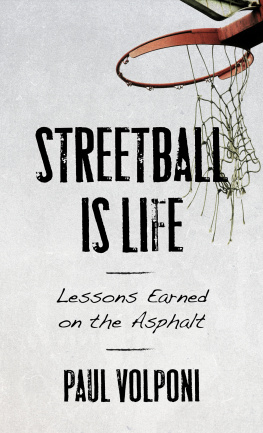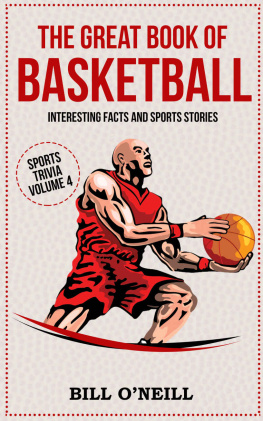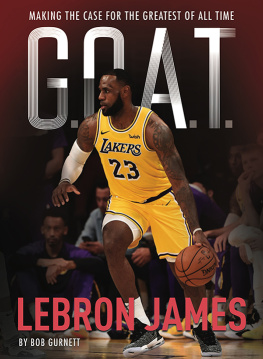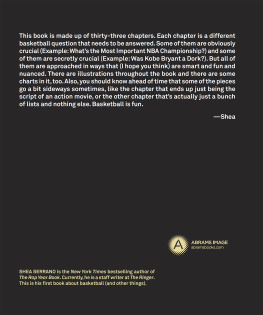Paul Volponi is an author, educator, and journalist. His twelve novels for young adults have received a dozen American Library Association honors. His novel Black and White, winner of the International Reading Associations Childrens Book Award, is a staple in many middle school and high school English classes. His novel The Final Four, recipient of five-starred reviews, is on the New York City Chancellors Ninth Grade reading list. Paul is also the author of two nonfiction sports-themed books for Rowman & Littlefield: Thats My Team: The History, Science and Fun behind Sports Teams Names, and Streetball Is Life: Lessons Earned on the Asphalt. All of his works can be viewed at paulvolponibooks.com.
W ho is the greatest athlete of all time? Thats an incredibly interesting debate. Why? Training methods, nutrition, and dozens of other important factors have vastly improved throughout the years, making comparisons of athletes from different eras a rather difficult argument. So weve chosen a pair of deserving and superversatile athletesa male and femalefrom roughly similar time periods. The debate floor is yours.
MILDRED BABE DIDRIKSON ZAHARIAS (19111956)
The formula for success is simple: practice and concentration, then more practice and more concentration. M. B. Z.
She was given the name Babe after hitting five home runs in a childhood baseball game by friends who compared her to baseball great Babe Ruth. Not an outrageous comparison considering Mildred Babe Zaharias would grow up to become perhaps the most talented woman athlete to ever compete in sports.
Born in Port Arthur, Texas, Babe Zaharias excelled at track and field, basketball, baseball, and golf. All of my life I have always had the urge to do things better than anybody else, said Zaharias. Before I was ever in my teens, I knew exactly what I wanted to be when I grew up. My goal was to be the greatest athlete that ever lived.
Coming out of high school in the late 1920s, an era when there were no college athletic scholarships for females, Texas-based employers were more than eager to hire Babe. Not because she was an expert seamstress, but so that she could play on their company athletic teams. It was a form of local advertising back thenfor a company to own a championship squad in a particular sport, with their company name splashed across the jersey.
Babe, though, aspired to higher competition. At the National AAU (Amateur Athletics Union) Track and Field Championships, Zaharias finished first in six separate events. That earned her a spot on the US Olympic Team and a trip to the 1932 Summer Olympics in Los Angeles, setting the stage for this Texas athletic legend to become an international hero.
Zaharias broke four world records during the gamestwo in the 80 meter hurdles, and one each in the javelin and high-jump. She won a pair of gold medals and a silver medal, becoming the only woman to ever win medals in running, throwing, and jumping events.
At the age of twenty-four, Babe began to play golf. Though she came to the sport late in life, Zaharias excelled at an exceedingly high level. She competed against men in a sanctioned pro event. Only four other women have ever attempted that. Golf is a game of coordination, rhythm, and grace; women have these to a high degree, noted Zaharias.
After winning female championship events in both the United States and England as an amateur, Zaharias turned pro in 1947 and dominated the womens circuit, becoming the Ladies Professional Golf Association (LGPA) leading money-winner in 1950 and 1951.
Babe Zaharias planned on playing golf until she was into her nineties, even if that meant hitting a golf ball from a rocking chair. Sadly, she passed away at fifty-six, her life taken by colon cancer. During her final years, Babe became an advocate for the American Cancer Society, using her fame to raise funds for future research.
Jim Thorpe Stamp.
Mildred Babe Didrikson Zaharias stamp.
JIM THORPE (18871953)
He could simply do it all, seemingly without effort. Having never high-jumped before, a teenage Jim Thorpe watched the track and field team practicing at his Carlisle, Pennsylvania, school. He walked up to the bar and easily out-jumped everyone there while wearing his street clothes.
Thorpe was born in the Indian Territories of the West (now Oklahoma). He was a Native American, a member of the Sac and Fox Nation. With his parents deceased, he relocated east where athletics became his passion. At the 1912 Olympics in Stockholm, Sweden, Thorpe won gold medals in both the pentathlon (comprised of five events) and decathlon (comprised of ten events). He was the first Native American to win gold for the United States.
I was never content unless I was trying my skill... or testing my endurance, said Thorpe. [But] I am no more proud of my career as an athlete than I am of the fact that I am a direct descendant of that noble warrior [Chief Black Hawk].
Six months after his Olympic triumphs, a newspaper story appeared stating that Thorpe had played minor league baseball one summer, receiving approximately $2 per day for expenses. Unlike many other athletes who also participated in pro or semipro sports to support themselves, Thorpe hadnt played under an assumed name.
The AAU, perhaps in prejudicial opposition to Thorpes Native heritage, stripped him of his Olympic medals.
In a letter to the AAU, Thorpe wrote, I hope I will be partly excused by the fact that I was simply an Indian schoolboy and did not know about such things. In fact, I did not know that I was doing wrong, because I was doing what I knew several other college men had done, except that they did not use their own names.
His honesty only helped to seal his fate.
John Chief Myers, Thorpes baseball roommate and fellow Native American, recalled, Jim was very proud of the great things hed done. A very proud man... Very late one night Jim came in and woke me up.... He was crying, and tears were rolling down his cheeks. You know, Chief, he said, the King of Sweden gave me those trophies, he gave them to me. But they took them away from me. Theyre mine, Chief; I won them fair and square. It broke his heart and he never really recovered.
With his loss of amateur status, Thorpe went on to play professional baseball for six seasons. He then played pro football, winning three NFL Championships before there was ever a Super Bowl. Finally, this incredible athlete began a career in basketball, barnstorming around the country with a team comprised completely of Native Americans.
During the later stages of his life, Thorpe struggled with severe alcoholism. In poverty, he died of heart failure at the age of sixty-five.
In 1982, the International Olympic Committee agreed to posthumously return Jim Thorpes medals to his surviving family members. The town of Jim Thorpe, Pennsylvania, is named in his honor.
TIME TO DEBATE
Perhaps you can approach your physical education teacher or coach and ask, Whos the greatest athlete of all time? When you receive an answer, make sure they explain their reasoning behind it. Thats an essential part of any debate, presenting clear and concise reasons for your opinion.
Debater #1: Babe Zaharias was an individual champion at several sports.
Debater #2: Jim Thorpe won team championships in different sports, making the other athletes around him better.










